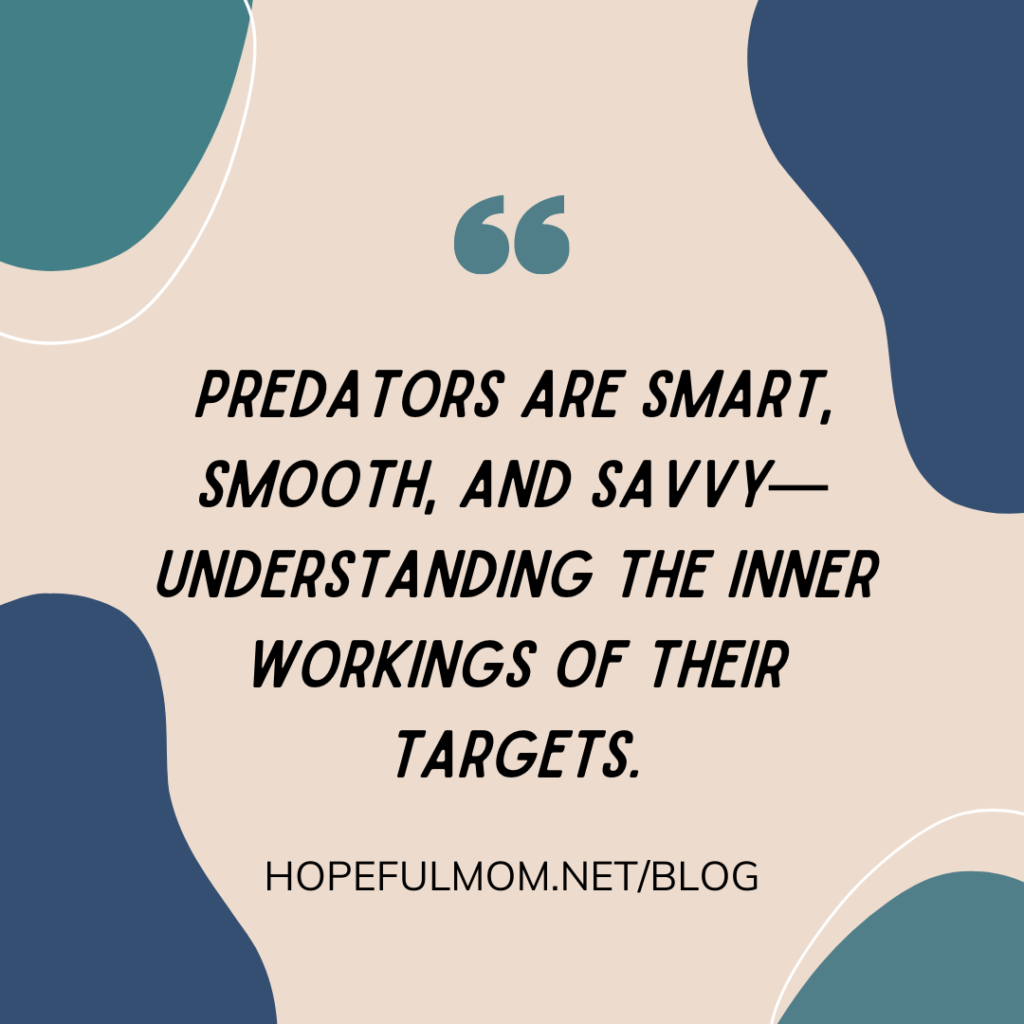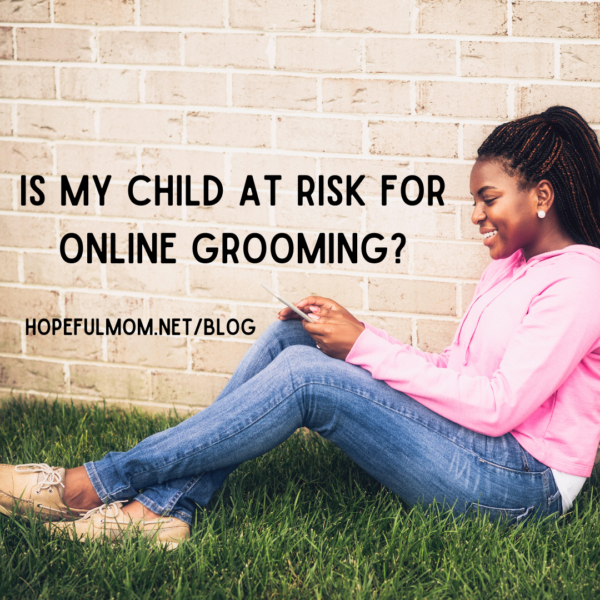What is online grooming for sex trafficking? Are our children at risk?
Why is it important to talk about this subject here at Hopeful Mom? Because the demand for pornography motivates traffickers. Those who watch pornography contribute to human trafficking. And our children are not only potential consumers of pornography, but also potential targets for sex traffickers. Yes, our children and their friends are potential targets.

Traffickers pursue the vulnerable. This may mean a child living in a home with only one parent, living in an impoverished situation, or one who is neglected and feels lonely. But, let’s face it, most preteens and teens feel insecure and inadequate at some point in their lives. Most face loneliness and a sense of doom periodically. And, yes, some are more susceptible than others. But all of our children, boys and girls alike, are at risk. Predators are smart, smooth, and savvy—understanding the inner workings of their targets.
Parents can help their children spot a potential groomer by talking with them about the signs and steps of a groomer.
Not all human trafficking victims are groomed, but grooming (preparing a child for a specific objective like sexual assault) is more likely to occur than abduction. End Slavery Now and the Polaris Project list the following steps in the grooming process:
1 – Targeting a Victim – Groomers troll social media for potential victims, as well as finding them in person. Groomers take on many forms. Catfishers, people who use a fake profile on a social media app, send personal messages. Teens slightly older than their intended targets befriend a potential victim in person and pretend to be interested in them. For example, a nineteen-year-old male may flirt with a sixteen-year-old female. Of course, she is flattered and may agree to be his girlfriend simply because he has filled a desire to be liked by a cute, older boy.
2 – Gaining Trust and Information – Groomers pose as someone who cares. They listen and tell the potential victim what they want to hear. Through casual conversation, they learn information to use against the victim later. For example, if a target mentions to their “friend” they can’t relate to their parents, the groomer may lure the victim somewhere under the pretense of being more relatable than the parents.
3 – Meeting Needs – Whether it’s telling a child he/she is loved, purchasing a gift, supplying drugs and alcohol, or listening, the groomer finds away to meet a need through the information obtained.
4 – Isolation – It’s at this point the relationship takes a turn. The groomer becomes more controlling by turning the victim against friends and family. The trafficker spends more time with the victim and pulls him/her away from others. This may be so subtle the target is unaware it’s happening. A red flag to watch for at this point is the “friend” telling their intended target to meet them somewhere and not to tell anyone.
5 – Exploitation/Abuse – Once the victim has been isolated and is dependent on the groomer (for drugs, alcohol or other material possessions) or the groomer is bribing the victim with information or sexually explicit photos, the exploitation or abuse begins. “The way traffickers begin the process of exploiting their victims isn’t always transparent. They may start slowly, by pushing their victim to do things they might be uncomfortable with, like asking them to have sex with a friend once or arranging a date for them as a way to make some quick money. Over time, the victim may be conditioned to believe that what they’re being asked to do is ‘normal.’ They may even feel like they owe their trafficker for all they have done for them or believe their trafficker when they say that the situation is just temporary or a way for them to reach their common goals, such as getting out of the sex trade and starting a family – or keeping the current, abusive family together.”[i]
6 – Maintaining Control – This could include continued isolation, extortion, threats, violence, or fear.
I recommend downloading A21’s student safety guide for an example of how exploitation may occur through a simple conversation. Use the guide as a resource to talk with your child. This A21 guide includes safety tips to discuss with your teen. This video is a great depiction of how easily sextortion can begin.
As with all of these difficult conversations, we want to broach the subject with the appropriate amount of concern and caution. In other words, don’t freak out! Let your preteens and teens know you’re aware of the dangers and available to talk. Ask them questions like: Have you heard of human trafficking? What do you know about it? Has anyone you haven’t met in person sent you a private message? Do you feel as if you are in danger? See if they have questions. If you don’t know the answer, do some research together.
Is My Child at Risk for Online Grooming? Learn the steps of the grooming process and talk about the dangers with your preteens and teens. #onlinegrooming #fightthenewdrug #humantraffickingawareness Share on XAs always, there is hope. Our children are intelligent and, with some guidance, can set boundaries regarding technology and stay within them as long as they understand the dangers and are motivated to stay safe. Keep talking! Your children and your relationship with them are worth the effort.
Thanks for reading. Next time we will hear from a public-school teacher. She has a unique perspective as someone in the classroom with our children all day. Be sure to subscribe below for a FREE PDF, updates on blog posts, and information regarding my upcoming book. Share this post with your friends. Doing so may help prevent a child from being exploited or trafficked.
[i] https://polarisproject.org/blog/2021/02/love-and-trafficking-how-traffickers-groom-control-their-victims/
About the author
Barb Winters is the author of Sexpectations: Helping the Next Generation Navigate Healthy Relationships and founder of Hopeful Mom. She’s a certified mental health coach and offers one-on-one consultations for parents. For more about Barb, click "About" in the menu.




2 Replies to “Is My Child at Risk for Online Grooming?”